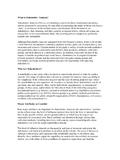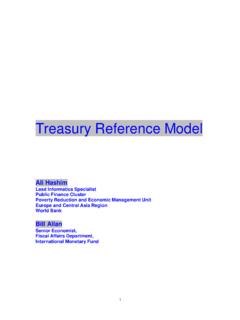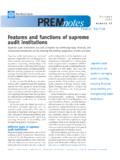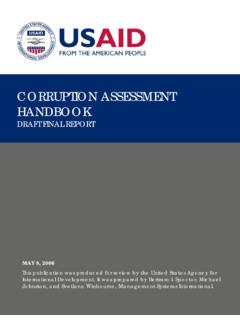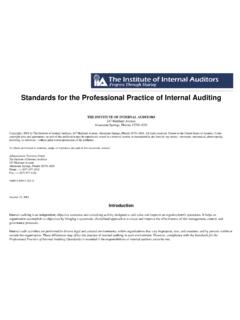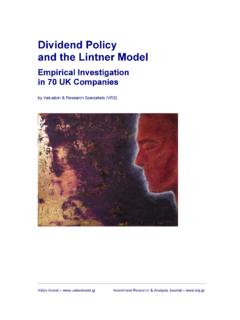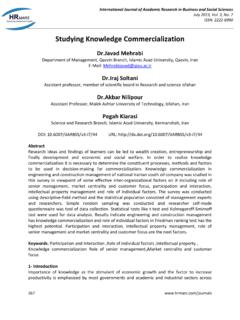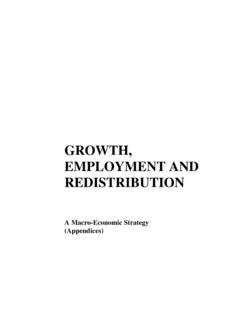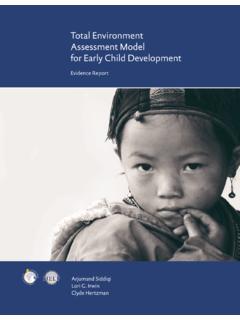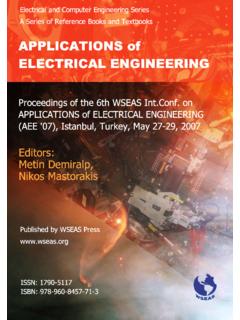Transcription of ETHIOPIA Anti-Corruption Report - World Bank
1 ETHIOPIA Anti-Corruption Report World Bank Poverty Reduction and Social Development Unit Africa Region December 1998 Table of Contents Acronyms and Abbreviations .. iii Executive Summary .. iv Recommendations .. viii I. Background .. 1 II. corruption : A Global Concern .. 2 III. Government s Views on the Causes of 3 IV. Government s Program to Improve Economic Governance and to Combat corruption .. 4 V. Problem Areas .. 5 VI. Analysis and Recommended 10 VII. Conclusions and Introduction of the Anti-Corruption Undertaking .. 16 Table 1 Classification of corruption Risks and Effects .. 6 Annexes 1 Legal and Judicial Reform .. 19 2 Civil Service 28 3 The Regulatory Environment .. 32 4 Financial Management .. 35 5 Public Procurement .. 38 6 Dialogue among Parliament, Civil Service, Civil Society, the Private Sector, and the Media.
2 44 iiiGOVERNMENT FISCAL YEAR July 7 - July 6 CURRENCY EQUIVALENTS Currency Unit: Ethiopian Birr (Br) Official Rate: US$ - Br (1997) ACRONYMS AND ABBREVIATIONS AU Anti-Corruption Undertaking APL Adaptable Program Lending BIS Bank for International Settlements CAS Country Assistance Strategy CEO Chief Executive Officer CIDA Canadian International Development Agency CPC Central Procurement Cell CS Civil Service CSRP Civil Service Reform Program CTC Central Tender Committee EDI Economic Development Institute of the World Bank EMCP Expenditure Management and Control Program EPRDF Ethiopian People s Revolutionary Democratic Front FDI Foreign Direct Investment FY Fiscal Year
3 GO Non-business Governmental Organisation GOE Government of the Federal Democratic Republic of ETHIOPIA IDF Institutional Development Fund LIL Learning and Innovation Loan MEDAC Ministry of Economic Development and Co-operation MOF Ministry of Finance NGO Non-governmental Organisation OAG Office of the Auditor General PAC Public Accounts Committee PFP Policy Framework Paper PMO Prime Minister s Office RIA Regional Internal Auditors SAC Structural Adjustment Credit TI Transparency International TPLF Tigrayan People s Liberation Front TGE UNDP Transitional Government of ETHIOPIA United Nations Development Program UNCITRAL United Nations Commission on International Trade Law USAID United States Agency for International Development ivReport of a World Bank Mission to Support the Program of the Federal Democratic Republic of ETHIOPIA to Improve Economic Governance and to Combat corruption Executive Summary 1.
4 At the request of the Government of the Federal Democratic Republic of ETHIOPIA , a multi-disciplinary World Bank mission visited ETHIOPIA from December 8 to 12, 1997 to examine ways to support Government s program to improve economic governance and to combat The mission's objectives were to assess the scope and status of Government's efforts to combat corruption , to Report its findings, and to suggest areas where the Bank could provide support. A specific objective was to investigate the use of an Anti-Corruption Undertaking (AU) in Bank procurement as a means of furthering Government s Anti-Corruption program. A follow-up mission visited ETHIOPIA from June 28 to July 10, 1998 to discuss the Report with Government. Based on these discussions, the Report has been adjusted to reflect a shared appreciation of the Government of ETHIOPIA s program to combat corruption .
5 2. The request that the Bank incorporate Anti-Corruption clauses into future agreements led the mission to determine whether the conditions set out in the recent revision to the Bank s Procurement Guidelines were met. Clause of the Guidelines specifies three criteria with which there must be accord before the Bank can incorporate an AU into procurement documents: the adequacy of existing laws on bribery the willingness of government to broaden the AU to other categories of procurement the existence of a satisfactory Anti-Corruption 3. Each criterion requires an assessment, but the third is the most encompassing. It requires an examination of the capacity of government institutions efficiently to manage the procurement and project implementation processes, detect corruption , establish a prosecutable case, and then shepherd it through the judicial process.
6 There must be a capacity to detect and prosecute corrupt practice both when contracts are being awarded 1 The mission members were: Roger Sullivan, Mission Leader and Manager, Institutional and Social Policy Unit, Mr. Steve Weissman, Sector Director, Operations Support; Mr. Jean-Jacques Raoul, Technical Specialist (Procurement); Mr. Iraj Talai, Senior Financial Management Specialist; Mr. Paatii Ofosu-Amaah, Chief Counsel; Mr. Mike Stevens, Principal Public Sector Management Specialist; Mr. Rick Stapenhurst, Public Sector Management Specialist and Mr. Jack, Titsworth Senior Public Sector Management Specialist. Susan Chase edited the Report . 2 These revisions were incorporated in the World Bank s procurement guidelines at the behest of the World Bank Board of Directors.
7 Vand when they are being implemented by a prime contractor, with or without sub-contractors. This requires an assessment of all the institutions of government with which a contractor might engage while implementing a project, because the AU applies equally to grand corruption and petty corruption . These institutions could include: registering or licensing authorities, providers of services such as telephones, electricity and water, operational ministries, with whom a contractor must collaborate, procurement authorities, customs, police, local government, the civil service commission, and so on. Should an institution or process appear wanting, its performance would be brought to a standard such that the Bank could collaborate with government to use an AU.
8 4. In an effort to understand corruption during this mission, members of the mission met key government officials, members of civil society, the private sector, and the donor and diplomatic communities, and reviewed documents relevant to this area of work. The observations and findings in this Report should be seen within the perspective of consultations with selected focus groups and individuals and the short period over which these took place. The Government of ETHIOPIA has agreed that it will carry out a corruption Survey with the assistance of the Economic Institute of Development of the World Bank (EDI) in the near future. The survey is expected to consult a broader spectrum of society and, therefore, enrich the basis for determining Anti-Corruption measures by the Government.
9 corruption : A Global Concern 5. The international community, increasingly concerned with corruption , has launched a wide range of Anti-Corruption activities. Defined as the abuse of public office for private gain, corruption can take many forms, but the current concern is with corruption in the public sector or at the interface between public and private Investigating and sanctioning corrupt practice are critical, but enforcement and punishment will not achieve sustainable results unless accompanied by efforts to correct underlying causes. Fighting systemic corruption should be addressed as part of a broad strategy for improving public sector performance. 6. The causes of corruption often lie in: policies, which give rise to favouritism, distortions, and perverse incentives; a regulatory regime, which imposes excessive burdens on the private sector; and an over-extended government, which cannot adequately reward its civil service.
10 Weak public sector financial management the mishandling of government procurement, inadequacies in public sector accounting and auditing, and failure to hold public officials accountable for misuse of public resources and deficiencies in the legal/judicial system are also factors. These factors lead to a breakdown in formal rules governing public and private sector behaviour and informal rules take over, with bribery becoming the norm. corruption flourishes when public 3 The mission s principal Ethiopian interlocutor, Dr. Kebede Tedesse, Minister in Charge of Social and Administration, asked us to expand this definition to read: The abuse of public and private office for personal gain, to reflect the fact that many corrupt practices entail benefits to two parties, one public and one private.
